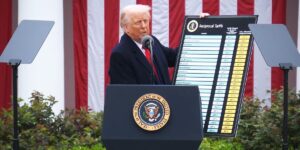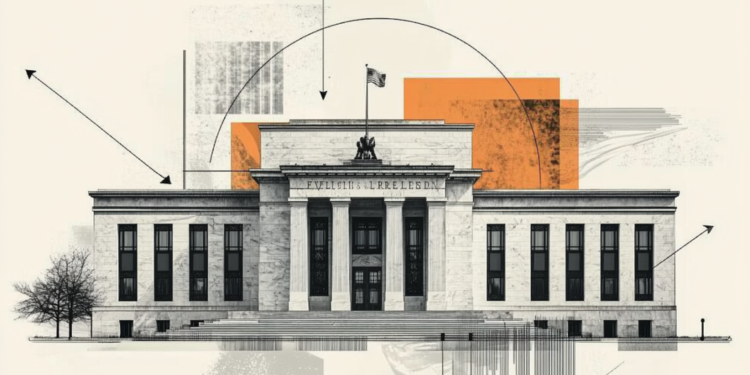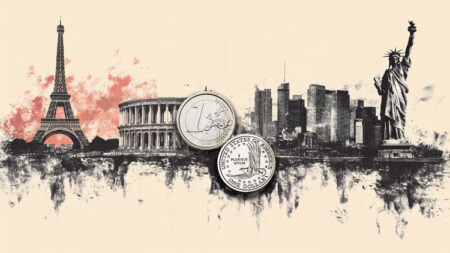- US Dollar Index gains traction to around 98.40 in Wednesday’s early Asian session, up 0.11% on the day.
- A cautious mood and geopolitical risks provide some support to the DXY.
- Rising Fed rate cut bets and trade uncertainties might cap the US Dollar’s upside.
The US Dollar Index (DXY), an index of the value of the US Dollar (USD) measured against a basket of six world currencies, drifts higher near 98.40 during the early Asian trading hours on Wednesday. The US JOLTS Job Openings and the Fed Beige Book will be released later on Wednesday.
The cautious mood in the financial markets and the ongoing Russia-Ukraine conflict boost the safe-haven flows, supporting the DXY. “Negative developments outside of the U.S. are probably what’s driving the market today, in terms of dollar strength,” said Vassili Serebriakov, FX strategist at UBS in New York.
Nonetheless, the prospect of the US Federal Reserve (Fed) rate cut this month, along with the dovish remarks from Fed officials, might undermine the US Dollar. Money markets are currently pricing in nearly a 91% odds that the Fed will cut rates by 25 basis points (bps) in the September meeting, up from an 85% possibility last week, according to the CME FedWatch tool.
The US Nonfarm Payrolls (NFP) data for July showed a slowing US labor market, with fewer jobs added than expected. This employment report has raised the likelihood of an interest rate reduction by the US central bank in September. Traders will take more cues from the NFP report for August later on Friday. The US economy is forecast to see 75K job additions in August, while the Unemployment Rate is projected to tick higher to 4.3% during the same report period.
Meanwhile, concerns over trade uncertainty might also drag the DXY lower. The US Court of Appeals for the Federal Circuit on Friday upheld a ruling that the sweeping tariffs the US President Donald Trump unilaterally imposed on most other countries were illegal. US President Donald Trump said late Tuesday that he would ask the Supreme Court for an “expedited ruling.”
US Dollar FAQs
The US Dollar (USD) is the official currency of the United States of America, and the ‘de facto’ currency of a significant number of other countries where it is found in circulation alongside local notes. It is the most heavily traded currency in the world, accounting for over 88% of all global foreign exchange turnover, or an average of $6.6 trillion in transactions per day, according to data from 2022.
Following the second world war, the USD took over from the British Pound as the world’s reserve currency. For most of its history, the US Dollar was backed by Gold, until the Bretton Woods Agreement in 1971 when the Gold Standard went away.
The most important single factor impacting on the value of the US Dollar is monetary policy, which is shaped by the Federal Reserve (Fed). The Fed has two mandates: to achieve price stability (control inflation) and foster full employment. Its primary tool to achieve these two goals is by adjusting interest rates.
When prices are rising too quickly and inflation is above the Fed’s 2% target, the Fed will raise rates, which helps the USD value. When inflation falls below 2% or the Unemployment Rate is too high, the Fed may lower interest rates, which weighs on the Greenback.
In extreme situations, the Federal Reserve can also print more Dollars and enact quantitative easing (QE). QE is the process by which the Fed substantially increases the flow of credit in a stuck financial system.
It is a non-standard policy measure used when credit has dried up because banks will not lend to each other (out of the fear of counterparty default). It is a last resort when simply lowering interest rates is unlikely to achieve the necessary result. It was the Fed’s weapon of choice to combat the credit crunch that occurred during the Great Financial Crisis in 2008. It involves the Fed printing more Dollars and using them to buy US government bonds predominantly from financial institutions. QE usually leads to a weaker US Dollar.
Quantitative tightening (QT) is the reverse process whereby the Federal Reserve stops buying bonds from financial institutions and does not reinvest the principal from the bonds it holds maturing in new purchases. It is usually positive for the US Dollar.
Read the full article here
















